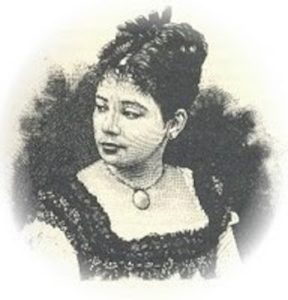
Maria
*Maria Firmina dos Reis was born on this date in 1825. She was an Afro Brazilian teacher, author, and abolitionist.
Maria Firmina dos Reis was born in São Luís, Maranhão, Brazil. "At age five, her mother and relatives moved to Viamão, where she attended school. In 1847, due to outstanding performance, she won a scholarship for further studies at the level of 'cadeira de primeiras letras' that prepared her to be a teacher." She maintained the profession ″until her retirement in 1881″. "At fifty-five, she founded a school for poor children." In 1859, Firmina dos Reis published her single major novel Úrsula (the same year Harriet Wilson published her Our Nig).

Her novel was a depiction of life for Afro-Brazilians under slavery. ″Úrsula, the main character, is a weak and sweet girl with whom two men are in love: one is a good person, the other a villain. Úrsula is expected to fall in love with the good man. However, she falls for the villain and becomes a victim of his cruelty. She is condemned and mistreated for having made the wrong choice. Reis shows through her characters that whenever women and slaves deviate from the established rules of the patriarchal system or refuse to accept the rules of society, they are punished. Furthermore, Úrsula, her mother, and some female slaves are portrayed from an inside perspective, showing a truthful historical point of view from Colonial Brazil. ″
Besides Úrsula, "Firmina dos Reis wrote poetry and short stories. While still in her twenties, she began collaborating with several local newspapers in her hometown of São Luis, an activity she sustained for many years. It was the only opening available to get her works published. She also "wrote an intimate, melancholic diary dating from 1853 to 1903 in which the themes of religious self-denial, death, and suicide recur". Maria Firmina dos Reis died on November 11, 1917.
In 1975, the Brazilian scholars Antônio de Oliveira and Nascimento Morais Filho recovered the long-forgotten Úrsula 1975 in a facsimile edition. As a "privileged free black woman within nineteenth-century colonial slave society″, Maria Firmina dos Reis ″stands out because she was very well-educated and a vigorous opponent of slavery." Dawn Duke considers Maria Firmina dos Reis and Cuban writer María Dámasa Jova Baró "eminent precursors to a distinguished line of subsequent women writers" in the Afro-Latin American context."
Horácio de Almeida believed Maria Firmina dos Reis to be the first Brazilian woman writer. [...] Luiza Lobo has since opposed the allegation by presenting Ana Eurídice Eufrosina de Barandas of Porto Alegre as the first female Brazilian novelist." But the "long-term symbolic value of Maria Firmina dos Reis's only novel Úrsula (1859) rests in its distinction as a work that lays the foundations for an Afro-Brazilian female literary consciousness."
For Rita Terezinha Schmidt, "Maria Firmina dos Reis inscribes a black voice in the construction of national subjectivities engendering what Homi Bhabha defines as a counter-narrative of the nation that 'continually evoke and erase its totalizing boundaries – both actual and conceptual – disturb those ideological maneuvers through which "imagined communities" are given essentialist identities."
In her Ph.D. thesis, Life Among the Living Dead, Carolyn Kendrick-Alcantara (2007) analyzes "the Gothic as a powerful abolitionist discourse in Brazil and Cuba through [her] readings of Maria Firmina dos Reis′ Ursula and Gertrudis Gomez de Avellaneda y Arteaga′s Sab."